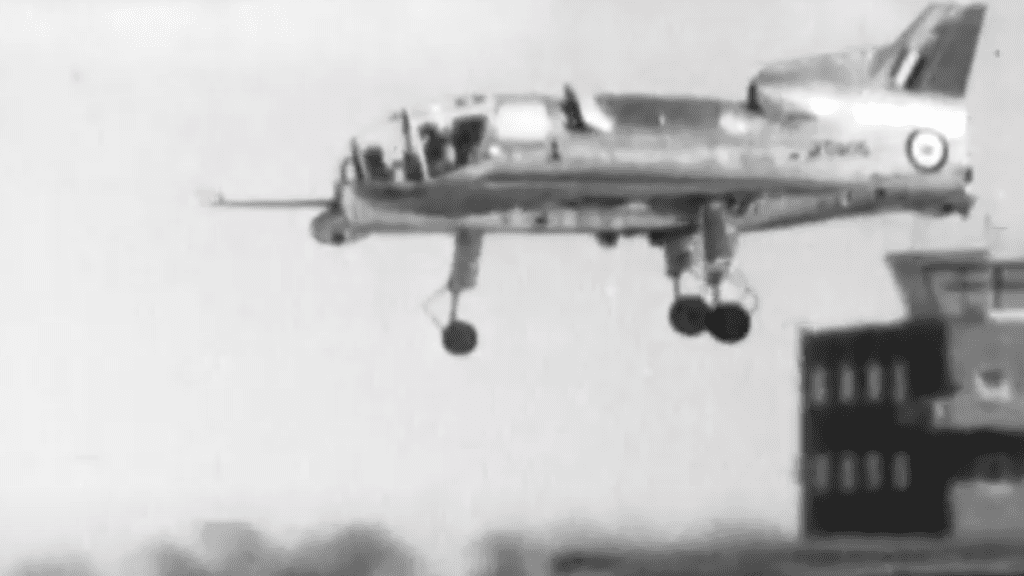The Short SC1 Was a Cold-War Experiment in Vertical-Takeoff Fighter Jets

Against the silver-gray sky in the old film reel, the bulbous jet lurches upwards like a flying saucer in an old Ray Harryhausen film. The Short SC1 aircraft, a British-built experimental plane, was the first fixed-wing plane built in the United Kingdom to prove that it could fly without a runway. It belongs to that formative era of the early Cold War where bare-metal jets stumbled through concepts and practices that would later be bent into useful form — including vertical takeoff.
Vertical Landing and Takeoff, or VTOL, is a hard technology with stark tradeoffs. Fixed wings and forward thrust from propellers — and especially from jets — enable planes to fly fast and for long distances. But such planes require runways, sometimes really long runways, to reliably operate. The rotors of helicopters offer reliable vertical take-off and landing from a much smaller landing pad, but pure rotor vehicles are constrained by their design, and fly much slower than planes in horizontal flight.
Figuring out VTOL in a reliable fashion took decades. Helicopters are used widely, as are many rotor-driven drones, but other aircraft have been harder to refine. The V-22 Osprey transport is a tilt-rotor plane whose engines pivot perpendicular to the ground for takeoffs and landings before laying down horizontally for forward thrust in flight. This vehicle took years of iteration to ensure traveling on one wasn’t automatically a death sentence.
Rather than pivot engines, when the Short SC1 was designed in the late 1950s, it relied on separate propulsion methods, with four dedicated turbojets for vertical lift, as well as one turbojet for forward motion. The SC1 was purely an experimental testbed: The lessons learned from it would go on to inform two generations of jets that entered service. At the time of its conception it was also seen as a transport precursor.
Both the United States and the United Kingdom today operate F-35Bs, jets that replaced Harrier VTOL jump jets, British-made fighters that came after the Short SC1. (Technically, the F-35B is a “short takeoff vertical landing,” or STOVL jet, but it fits into largely the same role.) The F-35B can still have takeoff trouble, like the one that crashed while landing in Fort Worth last December. Hovering down gently requires using powerful thrust to counteract gravity and forward momentum, but not too much.
The Short SC1 was first revealed to the public on December 18, 1956. Under the headline “New British Jet Unveiled,” the Associated Press said “Newspapers hailed the plane — the SC1 — as putting British ahead of the United States and Russia in the race to develop jets that can operate from small airfields instead of mile-long runways. The SC1 — SC stands for Strange Contraption — underwent its first taxiing trials at a guarded airfield in Belfast yesterday.”
Development of the SC1 was done as part of the UK’s, and NATO’s, broader effort to design a VTOL transport. A 1960 memo outlines the requirement for a VTOL transport: it must have the ability to fly low in all weather, take off and land from fields 500 feet long and with trees or buildings 50 feet high at the end. The transport should be able to carry 12,000 pounds as far as 500 nautical miles away, must have a cruising speed of at least 230 mph, and should be able to do all that while being simple to maintain and quick to unload and reload.
These requirements would allow the Short SC1, or whatever subsequent plane was built on its success, to support small units of armed scouts, resupply squads armed with missiles, and in general let a dispersed military operate while being resupplied. That role, in part, is now filled by helicopters and V-22s, with the SC1’s major innovations paving the way for faster fighter jets.
By 1961, NATO was already looking ahead to designing a supersonic VTOL plane, a goal that would be fulfilled by the Harrier. Lighter materials, as well as an approach that vectored thrust from one single engine, made the plane a better fit.
Later VTOL planes also ditched the stilt-like landing gear, which on the SC1 provided some protection from the massive heat thrust down below. This heat meant that, while the SC1 could take off and land vertically, it had to do so on concrete or other materials that could absorb the massive blast of hot jet exhaust without catching fire or blowing away, as might happen in a grass field.
Tragedy befell the SC1 on October 2, 1963, when one of the two planes built “experienced a failure of the gyro input to the auto-stabilizer. This sudden fault made the aircraft uncontrollable and it crashed from a height of about 40 feet (12.2 m), killing [Royal Aircraft Establishment] test pilot Richard Green when it turned over on impact,” writes Tony Buttler, in a masterful deep dive on the SC1.
The crashed plane was restored to operations, and the last flight of an SC1 for experimental research took place in May 1973. Today, both planes are museum pieces.
Like much of the early jet age, the SC1 is fascinating as an example of a direction not taken, its massive array of engines brute-forcing the answer to a problem that ultimately had a much more elegant solution.
In flight, as this film from 1960 shows, the SC1 is pleasingly inelegant. The vertical movement is smooth, the horizontal flight a little disjointed. Its three landing gear, tall on stilts, look like details left over from a child’s drawing of a plane. Watch it below:
Sc1 Vertical Take Off Plane (1960)



